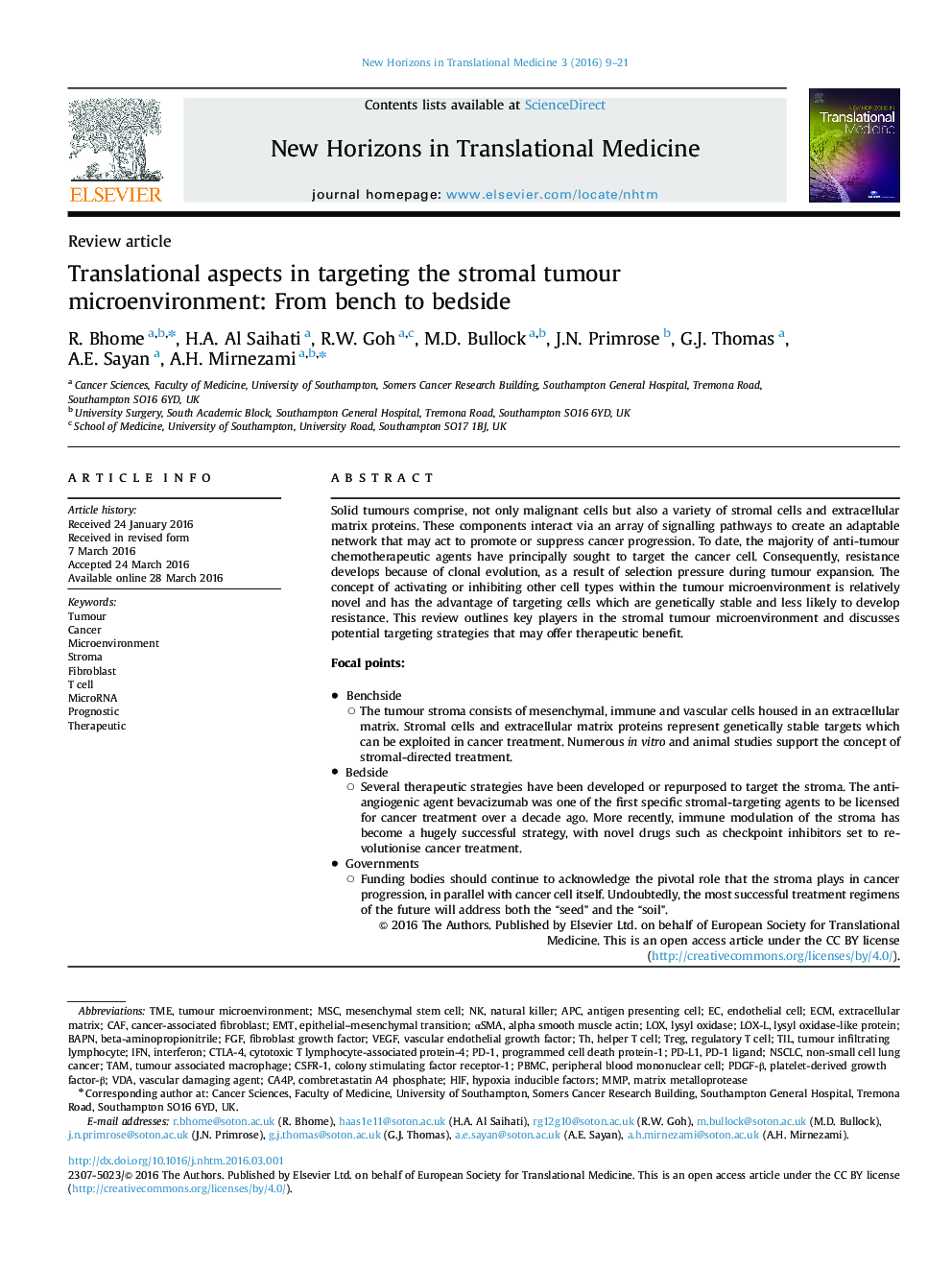| کد مقاله | کد نشریه | سال انتشار | مقاله انگلیسی | نسخه تمام متن |
|---|---|---|---|---|
| 10172223 | 1245962 | 2016 | 13 صفحه PDF | دانلود رایگان |
عنوان انگلیسی مقاله ISI
Translational aspects in targeting the stromal tumour microenvironment: From bench to bedside
ترجمه فارسی عنوان
جنبه های ترجمه در هدف قرار دادن میکروسکوپ های تومور استروما: از نیمکت به کنار تخت
دانلود مقاله + سفارش ترجمه
دانلود مقاله ISI انگلیسی
رایگان برای ایرانیان
کلمات کلیدی
PD-1 ligandFGFMSCVDAECMCTLA-4TMEAPCPD-L1PD-1Combretastatin A4 phosphateαSMABAPNCAFPDGF-βMMPCA4PPBMCTregHIFnatural killer - (سلول های) کشنده طبیعیalpha smooth muscle actin - آلفا آکتیو عضله صافStroma - استروماLOX - اکسیژن مایعinterferon - اینترفرونIFN - اینترفرون هاTIL - بهTAM - تامTumour - تومورEMT - تکنسین فوریتهای پزشکیTherapeutic - درمانیCancer - سرطانNSCLC - سرطان ریوی غیر سلول کوچکNon-small cell lung cancer - سرطان غیر سلول کوچک ریهRegulatory T cell - سلول T تنظیم کنندهPeripheral blood mononuclear cell - سلول تک هسته ای خون محیطیT cell - سلول تیEndothelial cell - سلول های اندوتلیالMesenchymal stem cell - سلول های بنیادی مزانشیمیHelper T cell - سلول کمک کنندهantigen presenting cell - سلولهای پردازنده آنتیژنplatelet-derived growth factor-β - عامل رشد پلاکتی-بتاHypoxia inducible factors - عوامل القایی هیپوکسیVascular endothelial growth factor - فاکتور رشد اندوتلیال عروقیVascular Endothelial Growth Factor (VEGF) - فاکتور رشد اندوتلیال عروقی (VEGF)fibroblast growth factor - فاکتور رشد فیبروبلاستFibroblast - فیبروبلاستcancer-associated fibroblast - فیبروبلاست وابسته به سرطانtumour infiltrating lymphocyte - لنفوسیت نفوذی تومورLysyl oxidase - لیسییل اکسیدازExtracellular matrix - ماتریکس خارج سلولیMatrix metalloprotease - ماتریکس متیل پروتئازایMicroRNA - میکرو RNA Microenvironment - میکرو محیطTumour microenvironment - میکرو محیط زیست تومورprogrammed cell death protein-1 - پروتئین مرگ سلولی برنامه ریزی شده -1Prognostic - پیش بینیEpithelial–mesenchymal transition - گذار اپیتلیال-مزانشیمی
موضوعات مرتبط
علوم پزشکی و سلامت
پزشکی و دندانپزشکی
پزشکی و دندانپزشکی (عمومی)
چکیده انگلیسی
Solid tumours comprise, not only malignant cells but also a variety of stromal cells and extracellular matrix proteins. These components interact via an array of signalling pathways to create an adaptable network that may act to promote or suppress cancer progression. To date, the majority of anti-tumour chemotherapeutic agents have principally sought to target the cancer cell. Consequently, resistance develops because of clonal evolution, as a result of selection pressure during tumour expansion. The concept of activating or inhibiting other cell types within the tumour microenvironment is relatively novel and has the advantage of targeting cells which are genetically stable and less likely to develop resistance. This review outlines key players in the stromal tumour microenvironment and discusses potential targeting strategies that may offer therapeutic benefit.Focal points:
- Benchsideâ The tumour stroma consists of mesenchymal, immune and vascular cells housed in an extracellular matrix. Stromal cells and extracellular matrix proteins represent genetically stable targets which can be exploited in cancer treatment. Numerous in vitro and animal studies support the concept of stromal-directed treatment.
- Bedsideâ Several therapeutic strategies have been developed or repurposed to target the stroma. The anti-angiogenic agent bevacizumab was one of the first specific stromal-targeting agents to be licensed for cancer treatment over a decade ago. More recently, immune modulation of the stroma has become a hugely successful strategy, with novel drugs such as checkpoint inhibitors set to revolutionise cancer treatment.
- Governmentsâ Funding bodies should continue to acknowledge the pivotal role that the stroma plays in cancer progression, in parallel with cancer cell itself. Undoubtedly, the most successful treatment regimens of the future will address both the “seed” and the “soil”.
- Benchsideâ The tumour stroma consists of mesenchymal, immune and vascular cells housed in an extracellular matrix. Stromal cells and extracellular matrix proteins represent genetically stable targets which can be exploited in cancer treatment. Numerous in vitro and animal studies support the concept of stromal-directed treatment.
- Bedsideâ Several therapeutic strategies have been developed or repurposed to target the stroma. The anti-angiogenic agent bevacizumab was one of the first specific stromal-targeting agents to be licensed for cancer treatment over a decade ago. More recently, immune modulation of the stroma has become a hugely successful strategy, with novel drugs such as checkpoint inhibitors set to revolutionise cancer treatment.
- Governmentsâ Funding bodies should continue to acknowledge the pivotal role that the stroma plays in cancer progression, in parallel with cancer cell itself. Undoubtedly, the most successful treatment regimens of the future will address both the “seed” and the “soil”.
ناشر
Database: Elsevier - ScienceDirect (ساینس دایرکت)
Journal: New Horizons in Translational Medicine - Volume 3, Issue 1, January 2016, Pages 9-21
Journal: New Horizons in Translational Medicine - Volume 3, Issue 1, January 2016, Pages 9-21
نویسندگان
R. Bhome, H.A. Al Saihati, R.W. Goh, M.D. Bullock, J.N. Primrose, G.J. Thomas, A.E. Sayan, A.H. Mirnezami,
